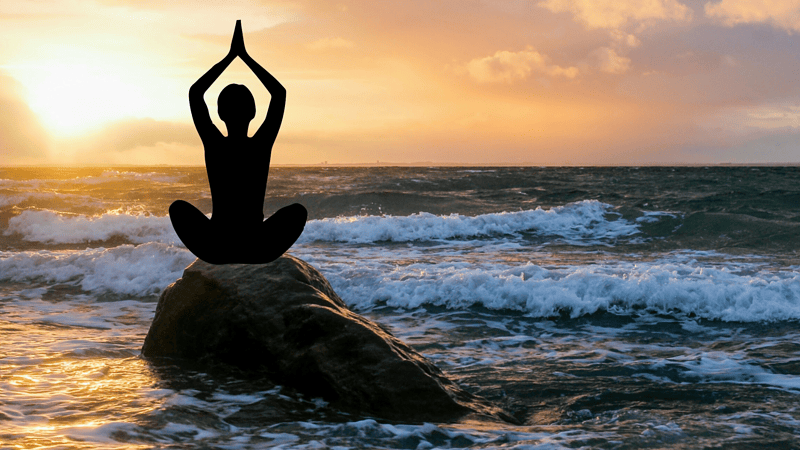
Karma Yoga
The Yoga of Awareness in Action - By Swami Nishchalananda
Reading time: 6 minutes
One of the main practices at Mandala Yoga Ashram is Karma Yoga. Many often wonder what this is, whether it is simply just "work", but it is so much more than that. It is an invaluable practice of awareness, should you choose to treat it as one. The rest of this article was written by Swami Nishchalananda, who is the Founding Director of the Ashram.
‘There are no menial jobs, only menial attitudes.’
One has to work to live. The path of Karma Yoga gives us the possibility of expanding our awareness and deepening perception whilst acting in the world. It is an essential aspect of Yoga, but few of us, even long-term practitioners of Yoga, grasp its significance. We tend to think that work cannot possibly be transformed into, or even have anything to do with, Yoga.
Karma Yoga usually becomes important and feasible only after we have gone a little deeper into other forms of Yoga such as Hatha, Mantra and Dhyana Yoga. It allows us the possibility of extending our practice of Yoga into our daily life, even into sleep and dreams2, twenty-four hours a day.
Karma Yoga is not merely work. Karma Yoga means to perform work to the best of our ability and with awareness, without being overly attached to the outcome or the results (or to the fruits, the term used in Yoga and in the Bhagavat Gita3). Ideally, moment to moment, work is an end in itself, the sense of self-importance diminished and work is done more and more without the obsessive sense of ‘me’, ‘I’ and ‘mine’. One becomes an instrument of action.
In fact, Karma Yoga flies in the face of what we have been conditioned to expect from work since the day we were born: payment, a pat on the back, self-expression, a sense of achievement. Yoga is not saying that we shouldn’t be paid, nor that we shouldn’t enjoy our work or develop our talents. All this is a natural part of life.
Going Beyond the Ego. However, if we want to go deeper into the secrets of our own Being and, indeed, of existence itself, then at a certain point in our lives we have to open up to possibilities which lie beyond the ego. This is where Karma Yoga comes in. Life and work go on, but the orientation changes so that instead of continually reinforcing our ego sense, bit by bit our actions free us from its limitations.
Essentially, Yoga is concerned with liberating us from ignorance and our limited sense of identification. Once the ego is reasonably healthy and fulfilled then its continuous satisfaction keeps us imprisoned at a certain level of awareness; it becomes a blockage to ongoing Spiritual evolution. Karma Yoga helps to free us from such limited identification with the needs of the ego, to break down the conditioning underlying our actions and awakens us to deeper levels of Being.
Removing Blockages. Activity in the form of Karma Yoga helps us expose our inner conflicts, our mental and emotional blockages. Inaction and living a secluded life cannot remove them and, though they are sometimes shifted in the course of daily life, it is often not the case. The blockages tend to lie dormant or fester in the deeper recesses of the mind.
It is when interacting with others during Karma Yoga that our personality’s limitations reveal themselves. When so exposed, the individual can then take active steps to remove them by discussing with friends or with those directly concerned, through meditation (i.e. introspective awareness) and even by autosuggestion.
When we work in the spirit of Karma Yoga we are more receptive; this can, and does, open us up to hidden aspects of the mind – known in Yoga as the process of ‘chitta shuddhi’, removal of mental and emotional blockages .
Developing Will and Concentration. Karma Yoga develops the will – here defined as the ability to harmonise, motivate, and mobilise all our abilities and actions to achieve a definite aim. By expressing our personality in the world through work and action whilst being in touch with deeper levels of our inner Being (i.e. Karma Yoga), we develop will-power.
The constant attempt to practise Karma Yoga also develops the faculty of concentration. In all forms of Yoga, the ability to concentrate is essential. Therefore the development of concentration during Karma Yoga can automatically help us follow other forms of Yoga, besides, of course, being of great practical use in running our lives.
Slowly, Slowly. In the early stages, Karma Yoga is more of an ideal than a reality. Even if we aspire to follow the path of Karma Yoga, our strong embedded sense of ego and total identification with our individuality hinders our efforts. Knowingly or unknowingly, we still crave the rewards for our efforts, or at least acknowledgement of our work in the form of respect or praise.
This is normal and all part of being human. But with practice - supplemented by other forms of Yoga - ego-centred traits, such as conceit and arrogance, become less and less and our sense of being an instrument increases. It is a question of dedication and perseverance. But it has to arrive naturally - otherwise we will be caught in the trap of thinking ‘I am not the doer’, when patently we do think we are the doer. This is just self-delusion that leads nowhere.
In its early stages, Karma Yoga is only work (i.e. karma), for we still possess a strong sense of personal needs. But by constantly absorbing oneself in work, and by also practising other forms of Yoga, we can slowly, but surely, bring about a change in our attitude to work and our place in existence. But it certainly doesn’t happen overnight!
We are Instruments. In our ignorance, we feel that ‘I am doing’. This creates pride (Sanskrit, abhimana) in us and brings about strife and disharmony. We don’t know, or realise, that we are only given the mandate to be able do or act by an ineffable Intelligence which is far vaster and more all-encompassing than our personality.
If we know this - really know it - then the ego-sense tends to diminish; moreover, we start to see the same Intelligence working through everyone and everything in the universe. As long as we act with selfish motives, we ultimately cause unhappiness to ourselves and to others.
Is it possible to act without selfish motives? Yes and no. Sometimes we are more selfish than at other times. Finally, the possibility to act without selfish motives can only arise when we have realised the Ineffable Presence within and everywhere around us. Then we acknowledge that this power alone is supreme and certainly far greater than the limitations of our personality.
When the individual no longer considers himself the doer but only an instrument, then work becomes spiritualised. The individual becomes efficient in action and develops equanimity of mind at all times and in all situations. Even where there is anger, it is not taken to heart, for how can one really become angry when one is only an instrument?
In every form of success or accomplishment, let us try to give less recognition to the ego, and more to the Intelligence which underlies everything. After all, as personalities, there is a severe limit to what we can do, even though we may think otherwise. The following story from the Mahabharata4 illustrates this point very clearly:
‘After the war, Arjuna5 was crossing a city with some possessions when some robbers attacked him. Exercising his fighting skills, Arjuna fought with all his strength against the robbers, but could not overcome them. All of his divinely given weapons were useless against them.
Since Krishna6 had already departed from the earth, Arjuna, totally despondent, went to see Sage Vyasa in order to find out why his weapons were so useless. Vyasa explained, ‘Oh Arjuna, those weapons never possessed any power, nor did you possess any power within yourself. It was all Krishna’s will that made you victorious during the Mahabharata. Now those weapons no longer have any purpose, so you may as well discard them.’ Arjuna then went and threw his weapons into the ocean’.7
Behind each of us there is Intelligence which is far greater than human intelligence. Without this greater Intelligence we cannot lift even a finger. This Intelligence underlies the changing seasons, the singing of a bird and the incredible complexity of the human genome.
As human beings, we are enabled to act and think only because of this Intelligence; every thought and act is permeated by It. This realisation is fundamental to Karma Yoga. Knowing that every success, and every failure, proceeds from this Intelligence, one feels a sense of humility, awe and gratitude.
The ego acts, and yet there is something ‘behind’ it which allows it to act. Realising this, we act in the spirit of Karma Yoga - we allow the mind and the senses to do their work unimpeded by the ego sense, remembering, or knowing, that the 'i’, the personality, is not really the doer.
Karma Yoga in Other Traditions. Though the path of Karma Yoga has been explained in detail by Yogic Science, references to it can also be found, directly or indirectly, in other traditions. (This is not surprising since Karma Yoga is a fundamental aspect of the Spiritual path).
Jesus said: ‘Thy will be done.’ 8
The entire essence of Karma Yoga is contained in this pithy statement. One tries to tune in with the underlying Intelligence that exists in all things and act accordingly. There is another statement:
‘The Father (Cosmic Intelligence) and I are one, but the Father is greater than I...the Father doeth the work.’
This is a mystical statement, uttered in a state of heightened awareness where the ego has evaporated. This is the state of Karma Yoga.
There are many other such statements in the Bible and in other Christian texts such as ‘The Practice of the Presence of God’ by Brother Lawrence9 (in which every word illustrates the glory of Karma Yoga – certainly well worth reading) .
The Chinese sages knew of the importance of Karma Yoga. Lao Tsu, who is said to have written the famous Taoist text, the ‘Tao Te Ching’, repeatedly says that ‘one should act as though one is not acting.’ That is, one acts externally but remains in touch with the Tao (Inner Presence) which is beyond action. Taoism says that we should try less and less to act from the ego; do what circumstances demand - if we have to fight, then fight; if we have to be quiet, then be quiet. But always we should aspire to be in touch with the Inner Presence.
Taoism has always been concerned with the perfection of action (i.e. Karma Yoga), whatever our role in life may be. Whether we are a builder, craftsman, computer boffin, farmer, house-wife (or house-husband!), or Yoga teacher – Taoism emphasises, as does Yoga, the importance of perfecting our skills and doing our best, even in difficult circumstances and with limited materials. The Tao Te Ching offers another pithy definition of Karma Yoga:
‘The man of power does not reveal that he possesses power;
therefore, he keeps it.
The man of lesser power tries to continuously demonstrate that he has power;
therefore, in fact, he is without it.
Moreover, the man of wisdom, the sage, does not really act,
whereas others (the unwise) do.’
Read the Tao Te Ching for yourself. Every line indicates the importance of blending into situations - not egotistically imposing oneself, but allowing oneself to respond appropriately - being Aware moment to moment. This is Karma Yoga. This doesn’t mean that one is passive, or indifferent, but rather that one is ready to act as and when required.
There is a beautiful quote by the sage Chuang Tsu:
"When you are betting for tiles in an archery contest, you shoot with skill. When you are betting for fancy buckles, you worry about your aim. And when you are betting for gold, you are a nervous wreck.”
Our inherent skill is the same in all these cases, but it is our attachment to the perceived outcome that creates such different results. Karma Yoga helps to bring about inner calm in all situations.
Judaism, Sufism, Buddhism, Sanatan Dharma (‘The Perennial Way’, also known as Hinduism, from which Yoga has evolved) and other religions, as well as various mystical systems, all emphasise what we would call Karma Yoga. They all indicate that acting with Awareness can take us deeper in our Spiritual perception and understanding.
They all advocate that freedom (from ignorance) doesn’t come from ‘escaping from life, but rather ‘escaping into Life.’ Every act - eating, talking, walking, digging, washing, thinking - presents us with the opportunity of being in touch with Reality – that is, Life (of the Spirit) as opposed to mundane life (of the senses). What is required is the right attitude, the right aspiration and the humility to accept that, as individuals, we are severely limited in our understanding and our capacity to act.
The Bhagavat Gita is the classical text on Karma Yoga. In it, Krishna (who symbolises the Cosmic Intelligence) urges us to live and act in the world, but with wisdom. To work blindly keeps us in (Spiritual) ignorance and to stop doing work also keeps us in ignorance. According to Yoga, there is no question of renouncing or neglecting work but rather renouncing the feeling of agency.
One purpose of Karma Yoga is to free us from our compulsions and lack of understanding. Arjuna was full of misconceptions (as we all are!); the practice of Yoga and the advice of Krishna (as explained in the Bhagavat Gita) de-hypnotised him and gave him Spiritual insight.
Many spiritually-minded people exalt a life of contemplation to the exclusion of action in the world. The Bhagavat Gita expounds a life of action, not selfish action, but a life which integrates contemplation (i.e. meditation) and action. It advocates balance of 'swadharma’10 - outward life, and 'swabhava’11 - inner being. Only then can actions become easy, creative and spontaneous.
The Bhagavat Gita emphasises that selfless actions are a fundamental aspect of human life:
‘The ‘spirit of service’ was created in the beginning as an indispensable part of human life. With selfless service nourish others that they may nourish you; in this way, everyone will attain the highest good. All human needs and desires are fulfilled by the devas (underlying laws and forces of nature) who are pleased by selfless actions.’ 12
This seems to contradict conventional thinking which tends to promulgate the idea that it is the aggrandisement of the ego and ‘everyone for themselves’ that is important. Everyone is predominantly concerned with their own welfare and satisfaction. But we can see that the more we pursue completely selfish ends, the more there is disharmony and stress; the fabric of family and society tends to break down. Consideration of others helps to engender harmony; in a wider perspective everyone gains and the ‘devas’ are pleased; everyone, more or less, is helped to be happy.
Furthermore, the Bhagavat Gita says:
‘The world is bound by selfish, not by selfless action. Therefore, Arjuna, act selflessly (or as much as you are able), free of attachments and without obsession for personal profit.’ 13
This leads to freedom, inner freedom. The Bhagavat Gita advocates that we should do what we do each day as well as we are able and, furthermore, dedicate our actions to a Higher Intelligence. Then we remain at peace, realising that the results are out of our hands. Thus we are slowly liberated from ignorance.
The essential teaching of the Bhagavat Gita is ‘Be an instrument in My Hands.’ In this way, a Yogic aspirant should try to submit his or her will to the Divine Will, the Total Intelligence of the cosmos and in this way move towards Self- Realisation.
Get a good translation of the Bhagavat Gita. Many of its 700 verses are directly concerned with Karma Yoga and its practical application in our lives. It gives many insights into the laws of action (karma) and human behaviour.
The Relation Between Karma and Bhakti Yoga. Karma Yoga and Bhakti Yoga may start off separately but at a certain point they merge and become one. Mother Krishnabai14 said:
‘When you feel that you are doing everything by the Will of God,
then you have realised the secret of surrender.’
Every act is dedicated to the underlying Intelligence in the flow of Karma Yoga. If your main path is Bhakti Yoga, then automatically everything that you do becomes Karma Yoga.
The Razor’s Edge. Yoga has always emphasised the importance of balancing the outer with the inner. The Ishavasya Upanishad15 says unequivocally:
‘Those who live a life only of action enter and remain in (Spiritual) ignorance. Moreover, those who reject action and retreat from the world, also enter and remain in ignorance.’ 16
Merely living a life of action, keeps us superficial in our understanding – we live in the illusion that the cosmetic appearance of things is Reality; our acts sustain our ignorance. On the other hand, neglecting the duties of daily life and being too introverted tends to reinforce our obsession with our personal needs; we remain self-centred, lacking understanding of others and their needs. Moreover, it is only by interaction with others that engrained mental blockages, conflicts and habits can be recognised and, in time, eliminated. Whilst these remain, they prevent us going deeper in understanding.
To go deeper in wisdom, Yoga says that we have to look within and start to understand how we function on a deeper level, whilst, at the same time, applying ourselves in action and developing our capacities to act in the world. This is Karma Yoga – yoking perception (inner and outer) with action. We are blessed with hands, legs and intellect – we should use them. Simultaneously we should start to get in touch with the deeper levels of our Being so that our actions benefit others, as well as ourselves.
Harmonising our life allows us to look inwards more deeply; in turn, looking inwards allows us to act more harmoniously and efficiently in the world. There is constant feedback between the inner and the outer – this is the boon of Karma Yoga.
Eventually, the difference between the inner and outer dissolves, as indicated by Ramana Maharshi:
‘Setting apart time for meditation is only for beginners. A person who is advanced (on the Spiritual path) will begin to enjoy deeper joy whether he is working or not. While his hands are in society, he keeps his head cool in solitude.’
Karma Yoga in an Ashram. One of the best places to get into the spirit of Karma Yoga is an Ashram. There are various reasons for this:
- The set-up and spiritual atmosphere of an Ashram are very conducive to Karma Yoga.
- In an Ashram, you generally have less vested interests in the work to be done. This doesn’t mean that you are sloppy, indifferent or negligent (many people totally misunderstand Karma Yoga in this way) - you do the given work to the best of your ability - but you are more able to let things happen moment to moment with Awareness.
- It is difficult to change our attitudes to work in daily life because of habitual patterns of behaviour. But insights which we may gain into the possibilities of Karma Yoga in the Ashram can then be applied at work.
Making our Lives a Work of Art. Martin Heidegger, the German philosopher, once said:
‘The artist should turn himself into that which wants to be revealed
and permit the process to happen through him.’
This doesn’t only apply to art: it also applies to every act in our lives. Karma Yoga is the endeavour to transform every act, every thought and every feeling into a work of art. Acts should be revealed through us. The Ineffable, the Inner Presence, should be allowed to express Itself perfectly, moment to moment, through the medium of our personality. Then we become an artist in the real, or Spiritual, sense of the word.
Karma Yoga in a Nutshell. In religious and spiritual circles, it is easy to use empty clichés like: "I am an instrument in the hands of God" but unless it is based on actual perception and understanding then it is merely empty words. We are all self-centred (some more than others); better to be honest. But, on the path of Yoga, we can aspire to realise, and actualise, the implications of the above statement.
This requires a quantum transformation in our understanding which Yoga, of all types, can bring about. Then Karma Yoga, where the head, heart and hands all flow with the same aspiration, becomes possible.
Karma Yoga is doing, but with a difference: it is doing to the best of our ability, with awareness, whilst being in the present moment, without attachment to the outcome of our actions. Easy to say, difficult to do! But, despite our imperfections, limitations and weaknesses, we can, at least, aspire and try.
A person who performs actions with attachment uses any means which serve his, or her, purpose and, in this selfishness, tends to cause unnecessary harm to others. People on the path of Karma Yoga may appear to be goal-orientated like everyone else, but inside they are peaceful since they are unattached.
Karma Yoga allows us to transcend karma. It gives us the opportunity of finding the Sacred in everyday acts and situations, moment to moment, as well as in every person and every thing we meet.
Karma Yoga would seem to be an impossible dream in the modern world which deifies the ego. But, if we are serious about going deeper in our understanding then we should give it a go. Besides, Karma Yoga can put us in touch with the transcendental level of Reality. Huang Po, the Chinese Yogi, said:
‘Don’t allow daily events and acts to bind you, but never stop doing them. Only by acting in this way can you become Enlightened.’
___________________
1 William Bennett
2 According to Yoga, even sleeping and dreaming are considered work or actions.
3 The text par excellence on Karma Yoga.
4 Classical text of Sanatan Dharma (Hinduism), which comprises 100,000 verses including the Bhagavat Gita (see later section).
5 A great warrior, hero of the Bhagavat Gita.
6 Guru of Arjuna, who also symbolises Cosmic Intelligence.
7 Extracted from an article by Swami Jyotirmayananda in Yoga International Guide.
8 The Lord's Prayer.
9 Translated by E. M. Blaiklock; pub. Hodder and Stoughton
10 This word has many meanings, but here it means ‘actions which come naturally to our personality.’
11 Literally ‘our inner nature.’
12 Chapter 3 verses 10,11 & 12.
13 Verse 3:9.
14 co-founder (with Swami Ramdas) of Anandashram in South India.
15 A classical text on Gyana Yoga (or Vedanta).
16 Verse 9.







